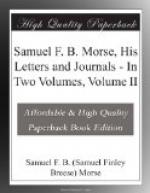“As the procession left the church it was headed by an officer bearing a pontoon;[1] then one bearing the silver crucifix; then eight or ten boys with lighted wax tapers by the side of the corpse; then followed the priests, six or eight in number, and then the relatives and friends of the deceased. At the grave the priests and assistants chanted a moment, the coffin was lowered, the earth thrown upon it, and then an elder priest muttered something over the grave, and, with an instrument consisting of a silver ball with a small handle, made the sign of the cross over the body, which ceremony was repeated by each one in the procession, to whom in succession the instrument was handed.
[Footnote 1: This must be a mistake.]
“There were, indeed, two or three real mourners. One young man in particular, to whom the female might have been related as wife or sister, showed all the signs of heartfelt grief. It did not break out into extravagant gesture or loud cries, but the tears, as they flowed down his manly face, seemed to be forced out by the agony within, which he in vain endeavored to suppress. The struggle to restrain them was manifest, and, as he made the sign of the cross at the grave in his turn, the feebleness with which he performed the ceremony showed that the anguish of his heart had almost overcome his physical strength. I longed to speak to him and to sympathize with him, but my ignorance of the language of his country locked me out from any such purpose....
“Accustomed to the proper and orderly manner of keeping the Sabbath so universal in our country, there are many things that will strike an American not only as singular but disgusting. While in Paris we found it to be customary, not only on week days but also on the Sabbath, to have musicians introduced towards the close of dinner, who play and sing all kinds of songs. We supposed that this custom was




